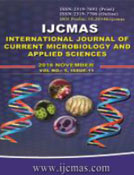


 National Academy of Agricultural Sciences (NAAS)
National Academy of Agricultural Sciences (NAAS)

|
PRINT ISSN : 2319-7692
Online ISSN : 2319-7706 Issues : 12 per year Publisher : Excellent Publishers Email : editorijcmas@gmail.com / submit@ijcmas.com Editor-in-chief: Dr.M.Prakash Index Copernicus ICV 2018: 95.39 NAAS RATING 2020: 5.38 |
Chronic suppurative otitis media is a condition characterized by inflammation of middle ear affecting tympanic membrane, middle ear mucosa and other middle ear structures. To isolate, identify and characterize the fungal organisms and to detect the antifungal susceptibility pattern of the isolates by using conventional microbiological methods from specimens of clinically proved cases of chronic suppurative otitis media. Two hundred and forty five patients with CSOM were studied. Swabs were collected from each patient and cultured for bacteria and fungus. Standard methods for isolation and identification of bacteria and fungus were followed. Antibiotic susceptibility testing was done by Kirby-Bauer’s disc diffusion method. Antifungal susceptibility testing was done by Disc Diffusion and Microbroth Dilution method. Out of the 245 samples studied for bacterial and fungal isolates, 225 samples showed growth of pathogens, 20 samples did not show any growth, 201 samples showed bacterial growth, The most predominant organism was Staphylococcus aureus, 24 samples showed fungal growth, Aspergillus sps being the predominant isolate. Antifungal susceptibility testing was also performed with discs fluconazole (10mcg) and itraconazole (10mcg) 23 isolates showed sensitivity to both and one resistant isolate was subjected to Minimum inhibitory concentration by Microbroth dilution method. Patients would be benefitted by accurate diagnosis of type of infection and the appropriate drug that will be sensitive for the infection can be administered to them.
 |
 |
 |
 |
 |